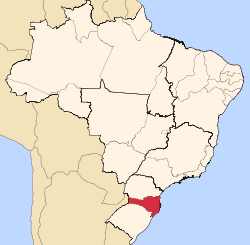Urussanga
Urussanga is a municipality in the state of Santa Catarina in the South region of Brazil.[1][2][3][4] The name means "very cold water" in the Tupi language.[5]
Urussanga | |
|---|---|
Municipality | |
 Flag  Seal | |
| Country | |
| Region | South |
| State | Santa Catarina |
| Mesoregion | Sul Catarinense |
| Time zone | UTC -3 |
Urussanga [note 1] is a municipality in the state of Santa Catarina, Brazil. It is at latitude 28º31'04 "south and longitude 49º19'15" west, being at an altitude of 49 meters, and 185 kilometers from the state capital Florianópolis. Its estimated population in 2004 was 19 110 inhabitants. It has an area of 237.41² kilometers.
Urussanga is also the name of the main river that cross the city. The village was founded by engineer Joaquim Vieira Ferreira on May 26, 1878 and emancipated on October 6, 1900. Main nucleus of Italian colonization in the south of the state, it stands out in gastronomy and wine production. It hosts the Wine Festival in even years, and Ritorno alle Origini in the odd ones: the first, always in August, and the second, on the city's anniversary, when the culture inherited from immigrants is celebrated, with much music, good food and good wine.
For a long time, the main economic activity was mineral coal extraction, once the town is located in one of the main coal regions of the country (with the municipalities of Lauro Müller, Siderópolis and Criciúma).
The most of current population's origin is Italian and the access roads to central area are SC-446 highway via Criciúma and Orleans and SC-445 via BR-101 (Morro da Fumaça).
References
- "Divisão Territorial do Brasil" (in Portuguese). Divisão Territorial do Brasil e Limites Territoriais, Instituto Brasileiro de Geografia e Estatística (IBGE). July 1, 2008. Retrieved December 17, 2009.
- "Estimativas da população para 1º de julho de 2009" (PDF) (in Portuguese). Estimativas de População, Instituto Brasileiro de Geografia e Estatística (IBGE). August 14, 2009. Retrieved December 17, 2009.
- "Ranking decrescente do IDH-M dos municípios do Brasil" (in Portuguese). Atlas do Desenvolvimento Humano, Programa das Nações Unidas para o Desenvolvimento (PNUD). 2000. Retrieved December 17, 2009.
- "Produto Interno Bruto dos Municípios 2002-2005" (PDF) (in Portuguese). Instituto Brasileiro de Geografia e Estatística (IBGE). December 19, 2007. Retrieved December 17, 2009.
- NAVARRO, E. A. Dicionário de tupi antigo: a língua indígena clássica do Brasil. São Paulo. Global. 2013. p. 606.
